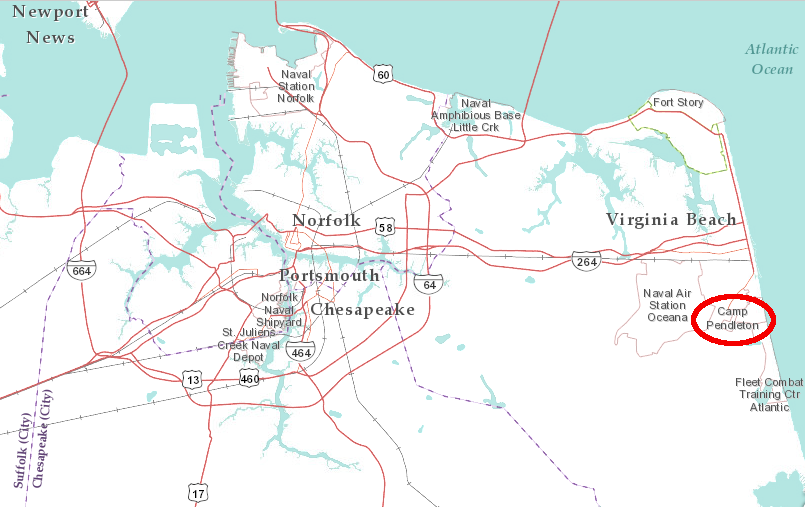 Camp Pendleton is a state military base in a region filled with Federal facilities
Camp Pendleton is a state military base in a region filled with Federal facilitiesSource: ESRI, ArcGIS Online
 Camp Pendleton is a state military base in a region filled with Federal facilities
Camp Pendleton is a state military base in a region filled with Federal facilities
Source: ESRI, ArcGIS Online
The units of the Virginia Volunteers, also known as "light infantry" in some communities, were the post-Civil War equivalent of the Virginia militia units that dated back to the 1600's. In a time when local sheriffs had few resources, the governor dispatched one or more units of the Virginia Volunteers when riots broke out. Those volunteer units were self-organized and self-funded, and their capabilities to handle different challenges were revealed during the Spanish-American War.
After passage of the Militia Act of 1903, the Federal government gradually assumed greater responsibility for funding volunteer units in the states. New Federal training standards required Virginia to provide a site for a two-week summer camp for military education, drill, and other training.
The General Assembly provided funding in 1908 to purchase a training ground for Virginia militia units. In 1912, a 400-acre State Rifle Range was established in Virginia Beach, on the Atlantic Ocean beach just south of Rudee Inlet. It served as the primary training site for the Virginia Volunteers, which were known after 1916 as the Virginia National Guard.1
The Virginia Beach site was located in an agricultural area where the price of land was low and there were few neighbors to complain about the noise of rifle practice. It was also conveniently close to the original Norfolk Southern Railroad.
 Camp Pendleton is bordered on the west by General Boothe Boulevard, on the east by the Atlantic Ocean, on the south by NAS Oceana Dam Neck Annex - and by residential subdivisions northwest of Lake Christine
Camp Pendleton is bordered on the west by General Boothe Boulevard, on the east by the Atlantic Ocean, on the south by NAS Oceana Dam Neck Annex - and by residential subdivisions northwest of Lake Christine
Source: US Geological Survey (USGS), Virginia Beach 7.5x7.5 topographic map (2013)
The US Navy used the site between 1917-1919. The Navy preferred Camp Pendleton over Fort Eustis for coastal artillery training in World War I, because the artillery could shoot over the undeveloped Atlantic Ocean waterfront without worrying about objections by landowners on the "receiving" end.
The state reclaimed the site at the end of World War I, and expanded it to 876 acres in part by by purchasing land east of Lake Christine. After the state moved the rifle range, space was available for additional training exercises, and the facility was called the State Military Reservation after 1928.
Between 1922-1942, the site was known by the name of the current governor of Virginia - Camp Trinkle, Camp Byrd, etc. During the Great Depression, the Civilian Conservation Corps (CCC) constructed about 30 buildings.
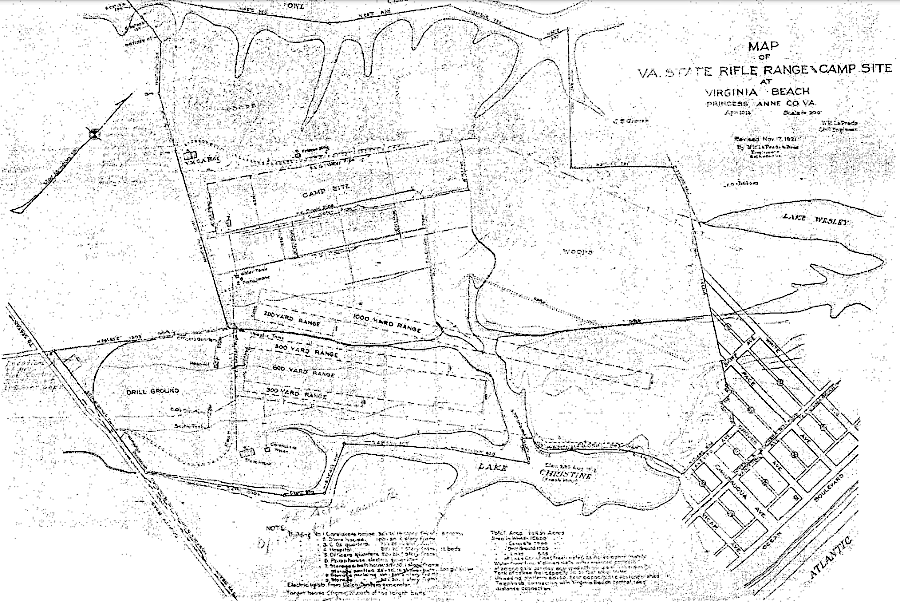 Camp Pendleton rifle range in 1923
Camp Pendleton rifle range in 1923
Source: Virginia Department of Historic Resources, Camp Pendleton/State Military Reservation Historic District - 2013 Additional Documentation Nomination
During World War II, the base was Federalized again, this time for use by the US Army. It constructed "temporary" barracks, because training would occur year-round rather than just in the summer months when soldiers could stay in tents.
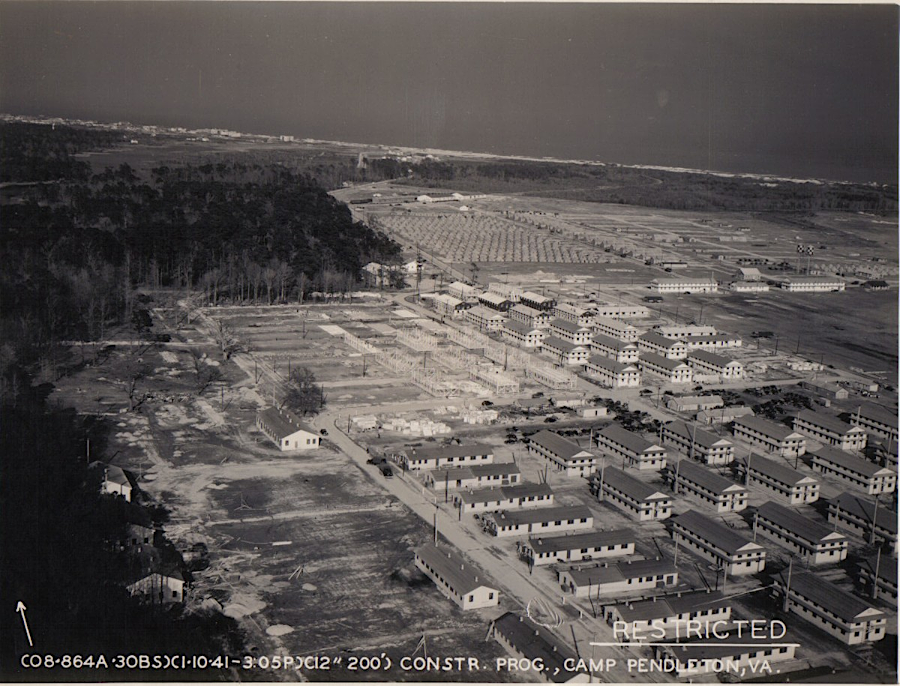 Camp Pendleton in World War II
Camp Pendleton in World War II
Source: US Army, Conserving Cultural Resources and Energy at Camp Pendleton
The US Army updated its World War I design for barracks and painted the buildings, rather than leaving them to weather. The 700 Series barracks buildings constructed at Camp Pendleton had a canopy above the windows, intended to deflect rain so windows could be left open for ventilation. The canopies were described as "eyebrows," though the US Army referred to them as "aqua medias" for unknown reasons. They were not very successful in blocking wind-blown rain at Virginia Beach.
Modern energy conservation projects have replaced the chimney and stovepipe heating systems, upgraded the lighting, added insulation, and instaled new roofs and windows in the barracks. The historic exterior appearances were preserved in the process.2
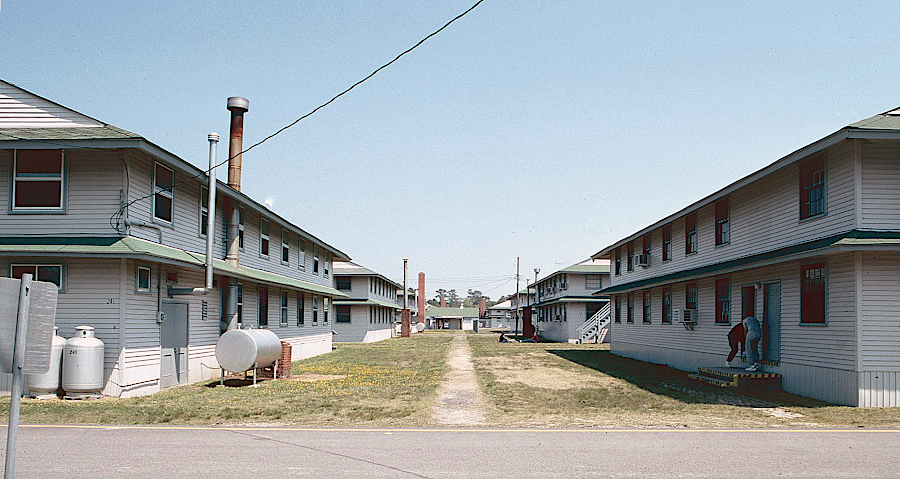 the two-story frame barracks built during World War II, with "eyebrow" canaopies, were still in use at Camp Pendleton in 1990
the two-story frame barracks built during World War II, with "eyebrow" canaopies, were still in use at Camp Pendleton in 1990
Source: Virginia Department of Historic Resources, 134-0413 Camp Pendleton/State Military Reservation (photo by Jeff O'Dell)
The US Army named the facility Camp Pendleton, which honors Brig. Gen. William Nelson Pendleton. Brig. Gen. William Nelson Pendleton was Robert E. Lee's chief of artillery during the Civil War, as well as an Episcopalian minister at Grace Church in Lexington.
Early in his Confederate career, Pendleton named the cannon in his 4-gun battery of the Rockbridge Artillery after the "canon" of the New Testament - Matthew, Mark, Luke, & John. His performance as Lee's artillery chief for the Army of Northern Virginia was less-than-stellar, especially at the Battle of Shepherdstown during the withdrawal after Antietam. In 1864, Lee eased him into a position where Pendleton retained his title but did not actually control the Confederate artillery.3
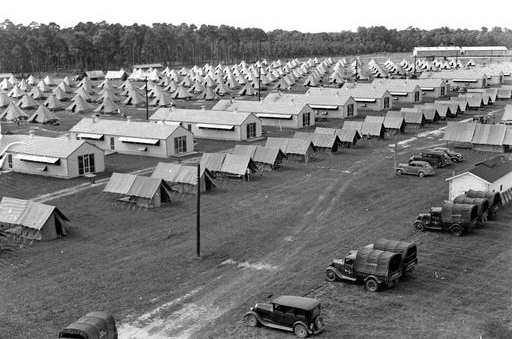 200 tents housed the 116th Infantry Regiment during training at Camp Pendleton in 1938
200 tents housed the 116th Infantry Regiment during training at Camp Pendleton in 1938
Source: Norfolk Public Library Sargeant Memorial Collection, National Guardsmen Training at Camp Pendleton - Virginia Beach, VA
Marine Corps Base Camp Pendleton in California was named after a different "Pendleton." Major General Joseph H. Pendleton was a Marine Corps general, born in Pennsylvania, who advocated creating a Marine Corps training base on the West Coast to complement the Quantico and Parris Island facilities on the East Coast.4
During the Cold War, the US Army needed larger locations than Camp Pendleton to train larger units, and National Guard training operations moved to places such as Fort Pickett and Fort A.P. Hill. Virginia had ended up acquiring 1,000 acres at Camp Pendleton, but there was no longer a need for all of it. Much was leased to the City of Virginia Beach for municipal and recreational purposes.
The Commonwealth of Virginia finally sold 567 acres of Camp Pendleton to the city, with the last sale in 2008. The state has retained 330 acres, including the high-value waterfront acreage where the US Navy conducted amphibious training exercises between 1947-1969.
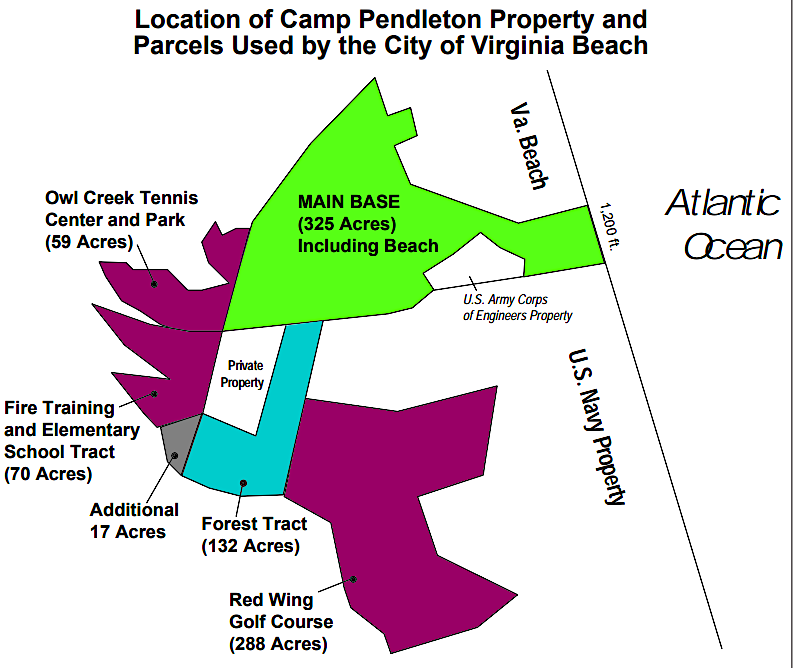 the City of Virginia Beach leased 417 acres from Camp Pendleton (three purple parcels) in 1998, and later purchased them
the City of Virginia Beach leased 417 acres from Camp Pendleton (three purple parcels) in 1998, and later purchased them
Source: Joint Legislative Audit and Review Commission, The Feasibility of Converting Camp Pendleton to a State Park
The state still leases 12 acres of Camp Pendleton to the Virginia Aquarium and Marine Science Center. That land is used for the parking lot on the east side of General Booth Boulevard.5
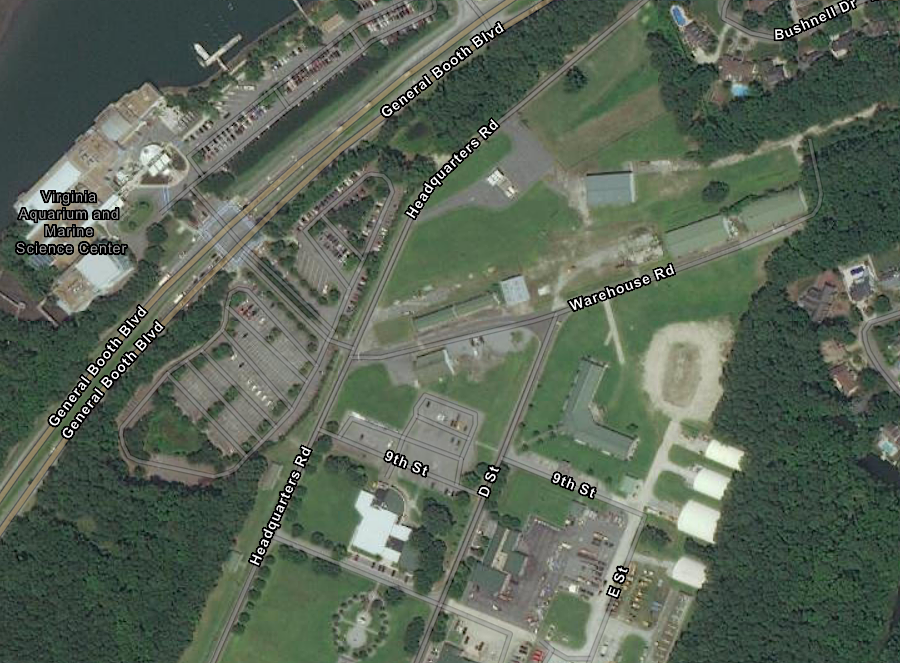 the parking lot for the Virginia Aquarium and Marine Science Center, between Headquarters Road and General Booth Boulevard, is on land leased from Camp Pendleton
the parking lot for the Virginia Aquarium and Marine Science Center, between Headquarters Road and General Booth Boulevard, is on land leased from Camp Pendleton
Source: ESRI, ArcGIS Online
Virginia governors have used Camp Pendleton as a retreat from the capital in Richmond, comparable to how Camp David in Maryland is used by the US president. What is now the Governor's Cottage, Building 90 in the inventory of Camp Pendleton, as originally constructed before World War I as the Commanding Officer's residence. Governor McDonnell proposed selling the Governor's Cottage in 2010 during an economic recession, but no action was taken.
Visits by governors have rarely attracted attention, but there were two exceptions. When Governor Godwin was attending the Democratic National Convention in August, 1968 in Chicago, his 15-year old daughter Becky was struck by lightning and killed on the beach at Camp Pendleton. Governor Robb's visits became controversial after it was revealed he had attended parties at Virginia Beach where illegal drugs were used.6
Today, Camp Pendleton serves as a vacation retreat, with cottages and trailers for rent to people with a valid military ID (as well as the governor). The Virginia Commonwealth ChalleNGe Youth Academy, part of the National Guard's program to help at-risk teens and high school dropouts, uses the facility as a residential camp.
One option for the future is to convert the site from a military base into a state park.
In 1998 the Joint Legislative Audit and Review Commission (JLARC), a part of the Virginia General Assembly, assessed the potential for converting Camp Pendleton into a state park:7
The study revealed that the costs of conversion were not insignificant. Because the public already has adequate access to oceanfront beaches, and both First Landing State Park and False Cape State Park are nearby, Camp Pendleton has remained a military base.
Another option is to transfer Camp Pendleton to the US Navy, incorporating it into NAS Oceana Dam Neck Annex. The Virginia Commission on Military Installations and Defense Activities made that recommendation in 2013, as part of its package of proposals to retain Federal bases in Virginia. Downsizing of the military after the end of the wars in Iraq and Afghanistan could have led to closure of NAS Oceana Dam Neck Annex.8
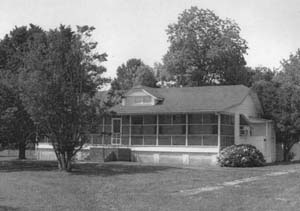 Governor's Cottage at Camp Pendleton
Governor's Cottage at Camp Pendleton
Source: Virginia Department of Historical Resources, Camp Pendleton (134-0413)
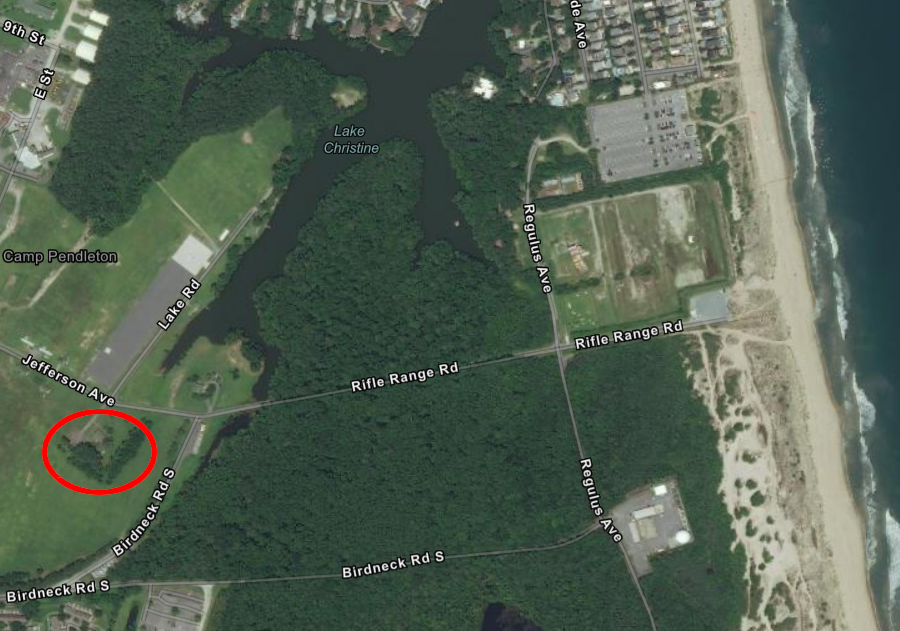 the Governor's Cottage is on the southern side of Lake Christine
the Governor's Cottage is on the southern side of Lake Christine
Source: ESRI, ArcGIS Online
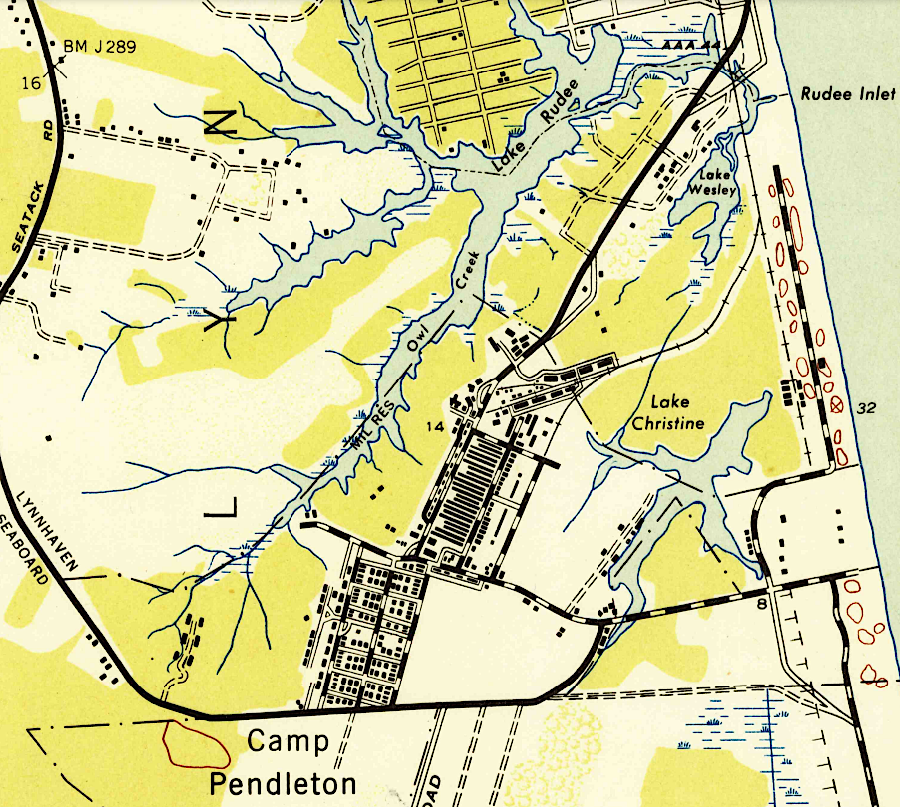 in 1948, Camp Pendleton was still isolated from the developed area in Princess Anne County
in 1948, Camp Pendleton was still isolated from the developed area in Princess Anne County
Source: US Geological Survey (USGS), Virginia Beach, VA 1:24,000 topographic quadrangle (1948)
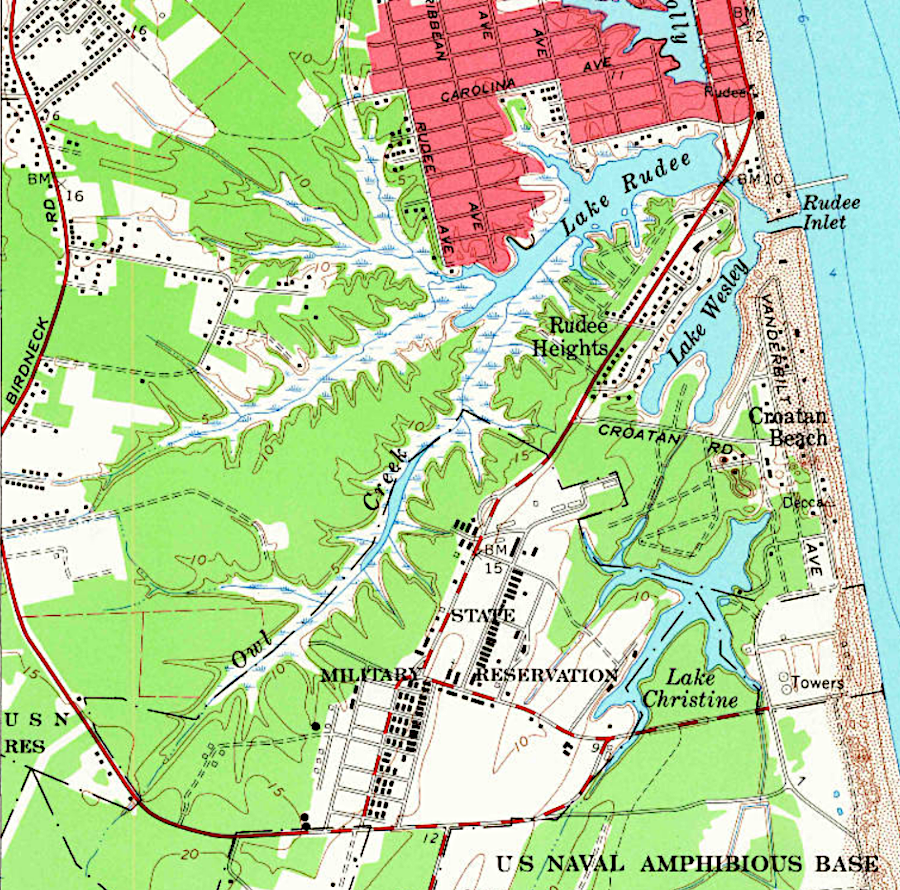 by 1965, suburban sprawl was beginning to approach Camp Pendleton
by 1965, suburban sprawl was beginning to approach Camp Pendleton
Source: US Geological Survey (USGS), Virginia Beach, VA 1:24,000 topographic quadrangle (1965)
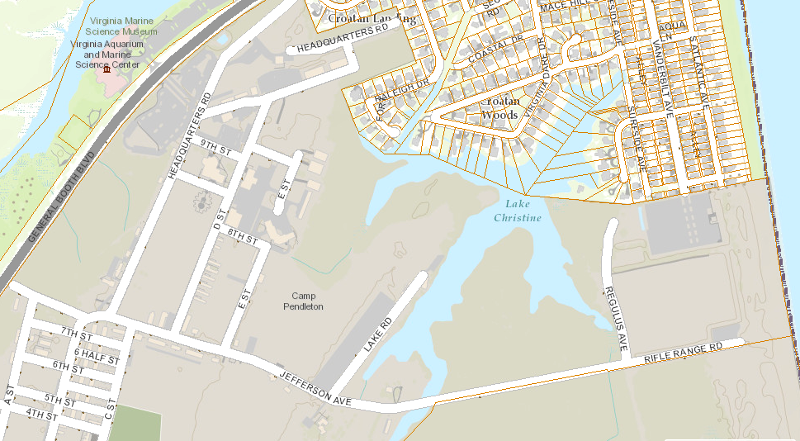 Croatan Landing is now developed on the north edge of Camp Pendleton
Croatan Landing is now developed on the north edge of Camp Pendleton
Source: City of Virginia Beach, Center for Geospatial Information Services